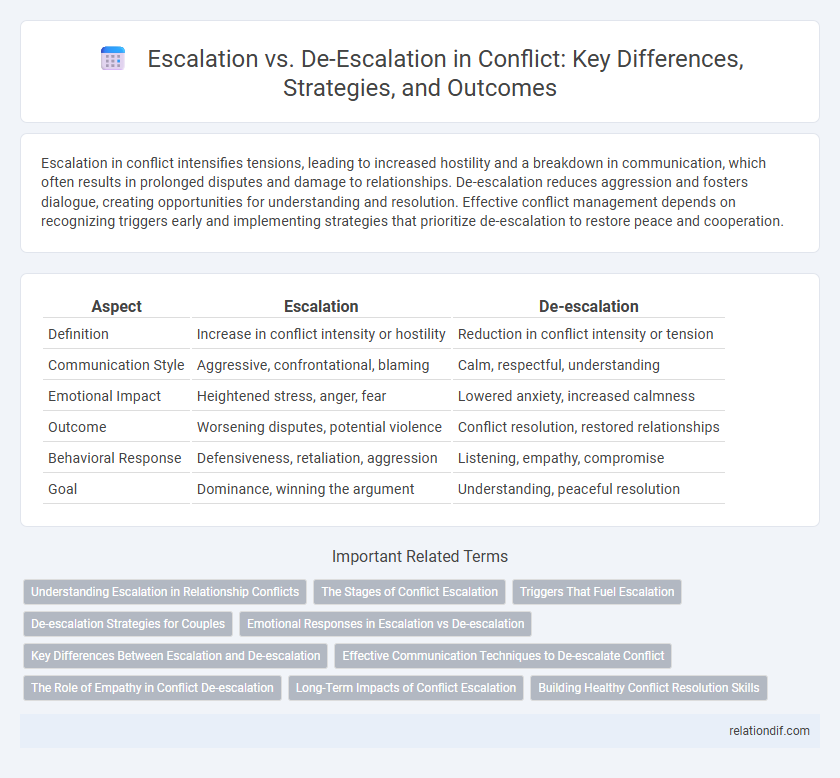Escalation in conflict intensifies tensions, leading to increased hostility and a breakdown in communication, which often results in prolonged disputes and damage to relationships. De-escalation reduces aggression and fosters dialogue, creating opportunities for understanding and resolution. Effective conflict management depends on recognizing triggers early and implementing strategies that prioritize de-escalation to restore peace and cooperation.
Table of Comparison
| Aspect | Escalation | De-escalation |
|---|---|---|
| Definition | Increase in conflict intensity or hostility | Reduction in conflict intensity or tension |
| Communication Style | Aggressive, confrontational, blaming | Calm, respectful, understanding |
| Emotional Impact | Heightened stress, anger, fear | Lowered anxiety, increased calmness |
| Outcome | Worsening disputes, potential violence | Conflict resolution, restored relationships |
| Behavioral Response | Defensiveness, retaliation, aggression | Listening, empathy, compromise |
| Goal | Dominance, winning the argument | Understanding, peaceful resolution |
Understanding Escalation in Relationship Conflicts
Escalation in relationship conflicts often arises from misunderstandings, unmet needs, and ineffective communication patterns that intensify emotional responses and trigger defensive behaviors. Key indicators include raised voices, accusatory language, and withdrawal, which exacerbate tensions and hinder resolution. Addressing escalation requires recognizing early warning signs and employing active listening, empathy, and conflict resolution techniques to shift towards de-escalation and constructive dialogue.
The Stages of Conflict Escalation
Conflict escalation progresses through distinct stages: latent tension, perceived conflict, felt conflict, manifest conflict, and conflict aftermath. Each stage intensifies emotional and behavioral responses, moving from underlying issues to open confrontation and potential resolution or deterioration. Understanding these phases enables targeted interventions to de-escalate tensions effectively before reaching critical confrontation.
Triggers That Fuel Escalation
Triggers that fuel conflict escalation often include perceived threats to identity, misunderstandings, and unresolved grievances. Emotional reactions such as fear, anger, and mistrust amplify tensions, leading to aggressive behaviors and entrenched positions. Recognizing and addressing these triggers early can prevent conflicts from intensifying into destructive confrontations.
De-escalation Strategies for Couples
Effective de-escalation strategies for couples include active listening, where partners attentively acknowledge each other's feelings without interruption, fostering empathy and reducing tension. Practicing mindful communication techniques, such as using "I" statements to express emotions without blame, helps prevent defensive reactions and promotes mutual understanding. Implementing regular pause intervals during heated discussions allows both individuals to cool down, reflect, and approach the conflict with a calmer, more constructive mindset.
Emotional Responses in Escalation vs De-escalation
Emotional responses in conflict escalation often include heightened anger, defensiveness, and anxiety, which intensify confrontations and reduce effective communication. In contrast, de-escalation involves managing emotions through empathy, active listening, and calm expression, facilitating understanding and resolution. Recognizing and regulating emotional triggers is crucial for shifting conflicts from escalation to de-escalation.
Key Differences Between Escalation and De-escalation
Escalation in conflict intensifies tensions through aggressive communication and actions, often leading to increased hostility and breakdowns in dialogue. De-escalation employs calming strategies such as active listening, empathy, and problem-solving to reduce hostility and restore constructive communication. Key differences include escalation's focus on confrontation and dominance, whereas de-escalation prioritizes mutual understanding and conflict resolution.
Effective Communication Techniques to De-escalate Conflict
Active listening and empathetic responses are critical in de-escalating conflict, as they validate feelings and reduce defensiveness. Utilizing calm, non-threatening language and maintaining a steady tone prevents escalation by promoting mutual understanding and respect. Techniques like open-ended questions and reflective statements encourage dialogue, allowing conflicting parties to identify common ground and resolve issues constructively.
The Role of Empathy in Conflict De-escalation
Empathy plays a critical role in conflict de-escalation by fostering understanding and reducing tension between conflicting parties. By actively listening and acknowledging the emotions and perspectives of others, individuals can create a foundation of trust that mitigates hostility and promotes collaborative problem-solving. Neuropsychological studies show that empathetic responses activate brain regions like the mirror neuron system, which enhances social bonding and emotional regulation during conflicts.
Long-Term Impacts of Conflict Escalation
Conflict escalation often results in prolonged hostility, increased casualties, and deep-rooted animosities that hinder future reconciliation efforts. Long-term impacts include economic destabilization, displacement of populations, and the breakdown of social cohesion within affected communities. Persistent escalation can entrench divisions, making sustainable peace more challenging to achieve over time.
Building Healthy Conflict Resolution Skills
Effective conflict resolution skills emphasize de-escalation techniques such as active listening, empathy, and clear communication to transform potential disputes into constructive dialogues. Escalation often arises from misunderstandings, emotional triggers, or poor communication, which can be mitigated by practicing patience and seeking common ground. Building these healthy conflict resolution skills fosters trust, reduces tension, and promotes collaborative problem-solving in personal and professional relationships.
escalation vs de-escalation Infographic

 relationdif.com
relationdif.com